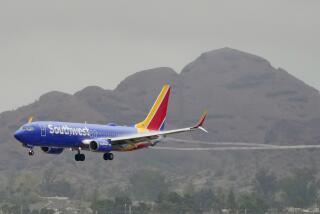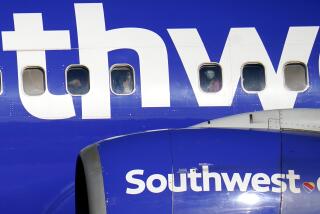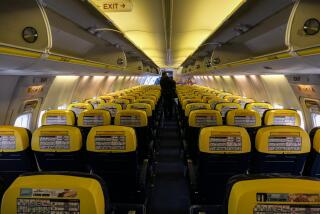15 minutes to a fitter air passenger
It’s an unlikely place to even think about exercising, crammed into an airplane seat barely big enough to hold a human, a magazine and a bottle of water. Yet one airline is promoting its seats as perfect places to get fit.
Song airlines, an Atlanta-based offshoot of Delta Air Lines, recently introduced In-Flight Fitness. The 15-minute workout is designed to work the core, the upper and lower body and to increase flexibility. For $8, passengers are given a resistance band, small ball and illustrated brochure, all neatly packaged in a carrying case.
The seven exercises, says the program’s developer, are designed to be done within the confines of the seat without clocking the person next to you. It helps that the airline’s 33-inch seat pitch -- the distance between rows of seats -- is a smidge larger than some other airlines, making it a bit easier to do the recommended glute extensions, triceps presses, dead lifts, chest presses, seated rows, etc. For the bicep curls, for example, one end of the band is placed around the foot while the arm, bent at the elbow, pulls the band toward the chin.
The idea for the program came about, according to a Song spokeswoman, when focus groups (made up mostly of women) mentioned exercise as an amenity they’d like to have on board, along with manicures. The airline nixed the second idea but liked the first, thinking it fit in with the company’s philosophy of giving its passengers choices, such as individual video monitors offering programming and food service that includes roast beef fajita wrap sandwiches and apple martinis.
“Do we think the entire airplane is going to want to do this?” asked Joanne Smith, Song’s vice president of marketing and customer service. “No, but we’re doing our little bit, like serving organic food. If we can find a way in society to make exercise easier and more accessible for people, I think we’re doing our part. If one or two people per flight buys a ball and band, we’ve done a good job.”
Exercise during flying, say health experts, is a good way to lessen the chances of deep vein thrombosis -- blood clots that can form in the legs during long periods of inactivity. It’s also called “economy class syndrome,” after the custom of stuffing people onto planes with little room to move about. But it can affect anyone packed into a small space for hours, such as soldiers confined to tanks. During most of Song’s workout program the legs are either moving or resisting the stretch of the band.
Song’s fitness program was demonstrated on a recent flight, where, Smith reports, some passengers felt the burn, and others slept through the entire presentation.
The package goes a notch beyond JetBlue Airways’ seat back pocket fitness guides. Two years ago that small economy airline, in conjunction with Crunch gyms, began providing passengers with illustrated yoga positions to encourage them to relax and feel better. Two months ago the company switched to Pilates, illustrating four stretches and core-strengthening moves performed without equipment in the seat.
JetBlue doesn’t know how popular the cards have been, because it doesn’t track how many passengers perform the exercises.
Song turned to muscleman and gym entrepreneur David Barton to develop its program. Though he barely rates a blip on the fitness radar screen in Los Angeles, he’s well known to New Yorkers familiar with his chain of upscale gyms that lure members with the slogan “Look better naked.”
Airline officials heard that Barton had devised his own in-transit fitness routine. He had been taking similar bands and balls for long plane rides and trips when a gym couldn’t be found at his destination. While on a flight to London, the self-described “fidgety guy” decided to break up the monotony of the trip by pulling out a resistance band he had stashed in his carry-on and working out in his seat.
“I thought people would be annoyed,” Barton recalls, “but they were very curious and sort of envious that I had something to do.” He’ll demonstrate the exercises in an in-flight video due in December.
Barton, like Smith, is realistic and doesn’t expect the majority of passengers to engage in a fitness routine while cruising at 35,000 feet above the earth. He believes the program will appeal to moderate exercisers -- those who make occasional trips to the gym. Couch spuds won’t bother, and gym rats may think the routine’s not challenging enough.
Barton says he hopes, though, that those who buy the program will consider using it in their hotel room or even at home.
“Ask someone why they don’t exercise,” he says, “and they’ll say they don’t have the time or money. This is $8 and takes 15 minutes, and you’re sitting on the plane anyway. I’m trying to erase the barrier of excuses so more people can exercise.”
The in-flight program is part of a bigger health picture, says Mike Bracko, a Calgary, Alberta, exercise physiologist and fellow of the American College of Sports Medicine.
“It fits in with trends that are promoting physically active lifestyles, such as designing walkable communities and providing work site health promotions,” he says.
And for people contemplating an exercise program, an $8 fitness kit could be the needed catalyst.
“Maybe they don’t know how to start, or are embarrassed to go to a health club,” says Bracko. “But if they buy a kit on an airplane, and they use it at home or a hotel where no one sees them, they could think, ‘I’m going to continue with this.’ ”
More to Read
Sign up for The Wild
We’ll help you find the best places to hike, bike and run, as well as the perfect silent spots for meditation and yoga.
You may occasionally receive promotional content from the Los Angeles Times.






